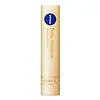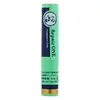What's inside
What's inside
 Key Ingredients
Key Ingredients

 Benefits
Benefits

 Concerns
Concerns

 Ingredients Side-by-side
Ingredients Side-by-side

Tocopheryl Acetate
AntioxidantStearyl Glycyrrhetinate
Skin ConditioningOlea Europaea Fruit Oil
MaskingPetrolatum
EmollientDiisostearyl Malate
EmollientHydrogenated Polybutene
Dipentaerythrityl Hexahydroxystearate
EmulsifyingCeresin
Emulsion StabilisingPhytosteryl/Octyldodecyl Lauroyl Glutamate
Skin ConditioningPhytosteryl/Isostearyl/Cetyl/Stearyl/Behenyl Dimer Dilinoleate
Skin ConditioningEthylhexyl Methoxycinnamate
UV AbsorberPolyglyceryl-6 Diisostearate
EmulsifyingPolyethylene
AbrasivePhytosteryl/Behenyl/Octyldodecyl Lauroyl Glutamate
Skin ConditioningMicrocrystalline Wax
Emulsion StabilisingParaffinum Liquidum
EmollientGlycerin
HumectantEuphorbia Cerifera Cera
AstringentTrehalose
HumectantHoney
HumectantRoyal Jelly Extract
Skin ConditioningDimethicone
EmollientButyl Methoxydibenzoylmethane
UV AbsorberBHT
AntioxidantWater
Skin ConditioningTocopherol
AntioxidantAlcohol Denat.
AntimicrobialCI 15985
Cosmetic ColorantCI 19140
Cosmetic ColorantTocopheryl Acetate, Stearyl Glycyrrhetinate, Olea Europaea Fruit Oil, Petrolatum, Diisostearyl Malate, Hydrogenated Polybutene, Dipentaerythrityl Hexahydroxystearate, Ceresin, Phytosteryl/Octyldodecyl Lauroyl Glutamate, Phytosteryl/Isostearyl/Cetyl/Stearyl/Behenyl Dimer Dilinoleate, Ethylhexyl Methoxycinnamate, Polyglyceryl-6 Diisostearate, Polyethylene, Phytosteryl/Behenyl/Octyldodecyl Lauroyl Glutamate, Microcrystalline Wax, Paraffinum Liquidum, Glycerin, Euphorbia Cerifera Cera, Trehalose, Honey, Royal Jelly Extract, Dimethicone, Butyl Methoxydibenzoylmethane, BHT, Water, Tocopherol, Alcohol Denat., CI 15985, CI 19140
Glycyrrhetinic Acid
Skin ConditioningNiacin
SmoothingTocopherol
AntioxidantOlea Europaea Fruit Oil
MaskingButyrospermum Parkii Butter
Skin ConditioningPetrolatum
EmollientGlycerin
HumectantDipentaerythrityl Hexahydroxystearate/Hexastearate/Hexarosinate
Skin ConditioningParaffin
PerfumingDiisostearyl Malate
EmollientEthylhexyl Methoxycinnamate
UV AbsorberButyl Methoxydibenzoylmethane
UV AbsorberPolyglyceryl-6 Diisostearate
EmulsifyingPolyethylene
AbrasiveMicrocrystalline Wax
Emulsion StabilisingPolyglyceryl-10 Pentahydroxystearate
EmollientPentylene Glycol
Skin ConditioningLanolin
EmollientGlycyrrhetinic Acid, Niacin, Tocopherol, Olea Europaea Fruit Oil, Butyrospermum Parkii Butter, Petrolatum, Glycerin, Dipentaerythrityl Hexahydroxystearate/Hexastearate/Hexarosinate, Paraffin, Diisostearyl Malate, Ethylhexyl Methoxycinnamate, Butyl Methoxydibenzoylmethane, Polyglyceryl-6 Diisostearate, Polyethylene, Microcrystalline Wax, Polyglyceryl-10 Pentahydroxystearate, Pentylene Glycol, Lanolin
 Reviews
Reviews

Ingredients Explained
These ingredients are found in both products.
Ingredients higher up in an ingredient list are typically present in a larger amount.
Also known as Avobenzone, this ingredient is a chemical sunscreen filter that provides protection in the UV-A range.
Avobenzone is globally approved and is the most commonly used UV-A filter in the world.
Studies have found that avobenzone becomes ineffective when exposed to UV light (it is not photostable; meaning that it breaks down in sunlight). Because of this, formulations that include avobenzone will usually contain stabilizers such as octocrylene.
However, some modern formulations (looking at you, EU!) are able to stabilize avobenzone by coating the molecules.
Avobenzone does not protect against the UV-B range, so it's important to check that the sunscreen you're using contains other UV filters that do!
The highest concentration of avobenzone permitted is 3% in the US, and 5% in the EU.
Learn more about Butyl MethoxydibenzoylmethaneDiisostearyl Malate is an emollient and most often used in lip products. It comes from isostearyl alcohol, a fatty acid, and malic acid, an AHA.
As an emollient, Diisostearyl Malate helps create a thin film on your skin to trap moisture in. This helps keep your skin soft and smooth.
Ethylhexyl Methoxycinnamate is an organic compound that provides UVB protection. It often goes by the more common name of octinoxate. It is created from methoxycinnamic acid and 2-ethylhexanol.
Ethylhexyl Methoxycinnamate absorbs UVB rays with wavelengths between 280-320 nm. UV absorbers protect your skin by using chemical reactions to convert UV rays into heat and energy.
UVB (290-320 nm) rays emit more energy than UVA rays. They are capable of damaging DNA, causing sunburns and are thought to be linked to skin cancer.
The state of Hawaii has banned sunscreens containing octinoxate due to its potential impact on coral reefs. More research is needed to bridge gaps in this research. The European Union allows higher levels of octinoxate in sunscreens than the US and Australia.
Ethylhexyl Methoxycinnamate is oil soluble. It is not stable and may lose efficacy when exposed to sunlight.
Learn more about Ethylhexyl MethoxycinnamateGlycerin is already naturally found in your skin. It helps moisturize and protect your skin.
A study from 2016 found glycerin to be more effective as a humectant than AHAs and hyaluronic acid.
As a humectant, it helps the skin stay hydrated by pulling moisture to your skin. The low molecular weight of glycerin allows it to pull moisture into the deeper layers of your skin.
Hydrated skin improves your skin barrier; Your skin barrier helps protect against irritants and bacteria.
Glycerin has also been found to have antimicrobial and antiviral properties. Due to these properties, glycerin is often used in wound and burn treatments.
In cosmetics, glycerin is usually derived from plants such as soybean or palm. However, it can also be sourced from animals, such as tallow or animal fat.
This ingredient is organic, colorless, odorless, and non-toxic.
Glycerin is the name for this ingredient in American English. British English uses Glycerol/Glycerine.
Learn more about GlycerinMicrocrystalline Wax is created by de-oiling petroleum. It is highly refined and purified before being added to cosmetics.
Microcrystalline Wax is used to enhance the texture and create even consistency. It helps stabilize a product by preventing ingredients from separating.
Olea Europaea Fruit Oil is the fixed oil obtained from the ripe fruit of the Olive. In other words - olive oil.
The primary contents of olive oil are glycerides of the fatty acids linoleic, oleic and palmitic.
Olive oil also contains antioxidants such as Vitamin E. Antioxidants may help reduce signs of aging by fighting unstable free-radical molecules. It also contains Vitamins A (retinol), D, and K.
The squalene in olive oil makes it a great emollient. Emollients help soothe and soften your skin by trapping moisture in. This makes olive oil a great skin moisturizer.
Studies show olive oil to have antibacterial and antifungal properties in low concentrations. Another study found olive oil irritated sensitive oily skin. We always recommend speaking with a professional about using this ingredient in your routine.
Due to the fatty acid content, this ingredient may not be fungal-acne safe.
Learn more about Olea Europaea Fruit OilPetrolatum is more commonly known as petroleum jelly. It is created by mixing waxes and mineral oils.
This ingredient is effective at reducing water loss by 99%. This is because it is an occlusive. Occlusives create a hydrophobic barrier on the skin to prevent evaporation. This property makes it great for hydrating dry skin.
Pro tip: Use occlusives, such as this ingredient, on damp skin for the best results.
The quality or origin of petrolatum is only known when disclosed by the brand. Most cosmetic petrolatum has gone through several purification stages.
Another benefit of occlusives is it protects your skin against infection or allergies.
Petrolatum may not be safe for fungal-acne. Studies show mineral oil / petroleum leads to the growth of M. Furfur, a type of yeast.
Learn more about PetrolatumPolyethylene is a synthetic ingredient that helps the skin retain moisture. It is a polymer.
It is also typically used within product formulations to help bind solid ingredients together and thicken oil-based ingredients. When added to balms and emulsions, it helps increase the melting point temperature.
Polyglyceryl-6 Diisostearate isn't fungal acne safe.
Tocopherol (also known as Vitamin E) is a common antioxidant used to help protect the skin from free-radicals and strengthen the skin barrier. It's also fat soluble - this means our skin is great at absorbing it.
Vitamin E also helps keep your natural skin lipids healthy. Your lipid skin barrier naturally consists of lipids, ceramides, and fatty acids. Vitamin E offers extra protection for your skin’s lipid barrier, keeping your skin healthy and nourished.
Another benefit is a bit of UV protection. Vitamin E helps reduce the damage caused by UVB rays. (It should not replace your sunscreen). Combining it with Vitamin C can decrease sunburned cells and hyperpigmentation after UV exposure.
You might have noticed Vitamin E + C often paired together. This is because it is great at stabilizing Vitamin C. Using the two together helps increase the effectiveness of both ingredients.
There are often claims that Vitamin E can reduce/prevent scarring, but these claims haven't been confirmed by scientific research.
Learn more about Tocopherol